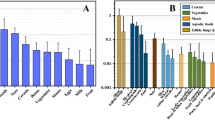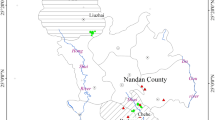Abstract
Dietary exposure to cadmium (Cd) in the Chinese population is currently a public health concern. China’s national standard for maximum limits (MLs) of Cd in foods needs to be assessed. The objective of this research is to estimate the impacts of different Cd MLs intakes from selected foods and food groups and to provide scientific evidence for ML establishment. Food consumption data were taken from the Chinese National Diet and Nutrition Survey. Cd contamination data were obtained from the National Food Contamination Monitoring Program. A beta binomial normal (BBN) model was applied in the probabilistic assessment. Different possible ML scenarios for rice were selected to assess the impact of different MLs on Cd concentration and intake. More than 70% of children aged 2–6 years and over 30% of the general population have a dietary daily Cd intake above provisional tolerable daily intake (PTMId). Cd intake changed greatly relative to baseline when different possible MLs were used, but the changes were not as large when compared among the different possible MLs. Cd exposure in China, especially for children, is a public health concern. It is recommended that the ML for rice be held at 0.2 mg/kg.


Similar content being viewed by others
References
Amzal B, Julin B, Vahter M, Wolk A, Johanson G, Akesson A (2009) Population toxicokinetic modeling of cadmium for health risk assessment. Environ Health Perspect 117:1293–1301. https://doi.org/10.1289/ehp.0800317
ANZFA (2013) Australia New Zealand Food Authority, Standard 1.4.1. Subscribe to food standards code contaminants and natural toxicants
CAC (Codex Alimentarius Commission) (2011) Codex Alimentarius Commission, Procedural Manual Twentieth edition
CAC (Codex Alimentarius Commission) (1995) Codex general standard for contaminants and toxins in foods. Codex Stan:193–1995
Chen J, Gao J (1997a) The Chinese Total Diet Study in 1992—chemical contaminants (I). Comparison between different areas. J Hyg Res 26:199–203
Chen J, Gao J (1997b) The Chinese total diet study in 1992—chemical contaminants. (II) Different age-sex groups. J Hyg Res 26:255–261
de Boer WJ, van der Voet H, Bokkers BG, Bakker MI, Boon PE (2009) Comparison of two models for the estimation of usual intake addressing zero consumption and non-normality. Food Addit Contam Part A Chem Anal Control Expo Risk Assess 26:1433–1449. https://doi.org/10.1080/0265200903161606
K.Egan TH, F.Kayama (2005) Cadmium-impact assessment of different maximum limits JECFA
European Commission (2006) Commission Regulation (EC) No. 1881/2006 of 19 December 2006 setting maximum levels for certain contaminants in foodstuffs. Off J Eur Union 364:5–24
Gao JQ, Li XW, Zhao JL (2006) 2000 Chinese total diet study—the dietary lead and cadmium intakes J Hyg Res 35:750–754
Gems/Food (1995) GEMS/Food-EURO second workshop on reliable evaluation of low-level contamination of food. Federal Republic of Germany, Kulmbach
Hoffmann K, Boeing H, Dufour A, Volatier JL, Telman J, Virtanen M, Becker W, De Henauw S, Group E (2002) Estimating the distribution of usual dietary intake by short-term measurements. Eur J Clin Nutr 56(Suppl 2):S53–S62. https://doi.org/10.1038/sj.ejcn.1601429
JACFA (2010a) Joint FAO/WHO expert committee on food additives, Joint FAO/WHO expert committee on food additives seventy-third meeting Geneva 6:12
JACFA (Joint FAO/WHO Expert Committee on Food Additives) (2010b) Long-term dietary exposure to lead in young children living in different European countries
JETRO (2009) Japan External Trade Organization, specifications, standards and testing methods for foodstuffs, implements, containers and packaging, toys, detergents
JETRO (2011) Japan External Trade Organization, specifications and standards for foods, food additives, etc. under the Food Sanitation Act (Abstract) 2010
Jiang D, Wang Z, Yang J, Lu J, Yang D (2012) Overview and analysis of food chemical contaminant monitoring in 2000–2009 in China. J Hyg Res 41:204–208
Li XW (2012) The application of TDS to evaluate the dietary intakes of trace elements. CCDC
Liu P, Li JX, Sun JF, Xue J, Chen BW, Zhang H, Yu XJ, Wang CN, Yuan BJ, Ma YJ, Tian ZH (2010a) Development and verification of Chinese dietary exposure evaluation model software. Zhonghua yu fang yi xue za zhi Chin J Prev Med 44:204–208
Liu P, Wang CN, Song XY, Wu YN (2010b) Dietary intake of lead and cadmium by children and adults—result calculated from dietary recall and available lead/cadmium level in food in comparison to result from food duplicate diet method. Int J Hyg Environ Health 213:450–457. https://doi.org/10.1016/j.ijheh.2010.07.002
Liu P, Li CY, Wang CN, Sun JF, Min J, Hu D, Wu YN (2011) Calculation of the dietary exposure of Chinese consumers to acephate residues using deterministic and probabilistic approaches. Food Addit Contam Part A Chem Anal Control Expo Risk Assess 28:649–658. https://doi.org/10.1080/19440049.2011.563368
Ministry of Health of the People’s Republic of China (1994) Contaminants limits in food. GB15201-94
Ministry of Health of the People’s Republic of China (2005) Contaminants limits in food. GB2762-2005
Shimbo S, Zhang ZW, Watanabe T, Nakatsuka H, Matsuda-Inoguchi N, Higashikawa K, Ikeda M (2001) Cadmium and lead contents in rice and other cereal products in Japan in 1998–2000. Sci Total Environ 281:165–175
Standardization Administration of the Ministry of Health (2003) Determination of Cd in foods. GB/T5009.15-2003 Beijing (China): Standardization Administration of the Ministry of Health of the People’s Republic of China
Sun JF, Liu P, Chen BW, Chen QG, Yu XJ, Wang CN, Li JX (2010) Establishment of non-parametric probabilistic model for evaluation of Chinese dietary exposure. Zhonghua yu fang yi xue za zhi Chin J Prev Med 44:195–199
Tooze JA, Kipnis V, Buckman D, Carroll RJ, Freedman LS, Guenther PM, Krebs-Smith SM, Subar AF, Dodd KW (2010) A mixed-effects model approach for estimating the distribution of usual intake of nutrients: the NCI method. Stat Med 29:2857–2868. https://doi.org/10.1002/sim.4063
Wang M, Wang Z, Ran L, Han H, Wang Y, Yang D (2003) Study on food contaminants monitoring in China during 2000–2001. J Hyg Res 32:322–326
Watanabe T, Zhang ZW, Moon CS, Shimbo S, Nakatsuka H, Matsuda-Inoguchi N, Higashikawa K, Ikeda M (2000) Cadmium exposure of women in general populations in Japan during 1991–1997 compared with 1977–1981. Int Arch Occup Environ Health 73:26–34
Watanabe T, Nakatsuka H, Shimbo S, Yaginuma-Sakurai K, Ikeda M (2013) High cadmium and low lead exposure of children in Japan. Int Arch Occup Environ Health 86:865–873. https://doi.org/10.1007/s00420-012-0821-1
WHO (1993) World Health Organization, Codex Classification of Foods and Animal Feeds Joint FAO/WHO Food Standards Programme, Codex Alimentarius Commission
WHO (World Health Organization) (2010), Exposure to cadmium: a major public health concern
Xue J, Zartarian V, Wang SW, Liu SV, Georgopoulos P (2010) Probabilistic modeling of dietary arsenic exposure and dose and evaluation with 2003–2004 NHANES data. Environ Health Perspect 118:345–350. https://doi.org/10.1289/ehp.0901205
Zhang L, Gao J, Li X (2008) Chinese Total Diet Study in 2000. Cadium intakes by different age-sex population groups. J Hyg Res 37:338–342
Zhang W, Li Q, Shi L, Lu K, Shang Q, Yao L, Ye G (2009), Investigation of dietary intake of cadmium in certain polluted area of south in China, J Hyg Res 38:552–554, 557
Funding
This study was supported by Research Projects of Public Welfare Industry of Grains in China (201513006), the National Natural Science Foundation of China (grant number 81273080), and the National Science and Technology Support Program of China (grant number 2012BAK01B00).
Author information
Authors and Affiliations
Corresponding author
Additional information
Responsible editor: Philippe Garrigues
A.Electronic supplementary material
ESM 1
(DOC 68 kb)
Rights and permissions
About this article
Cite this article
Liu, P., Zhang, Y., Su, J. et al. Maximum cadmium limits establishment strategy based on the dietary exposure estimation: an example from Chinese populations and subgroups. Environ Sci Pollut Res 25, 18762–18771 (2018). https://doi.org/10.1007/s11356-018-1783-y
Received:
Accepted:
Published:
Issue Date:
DOI: https://doi.org/10.1007/s11356-018-1783-y




